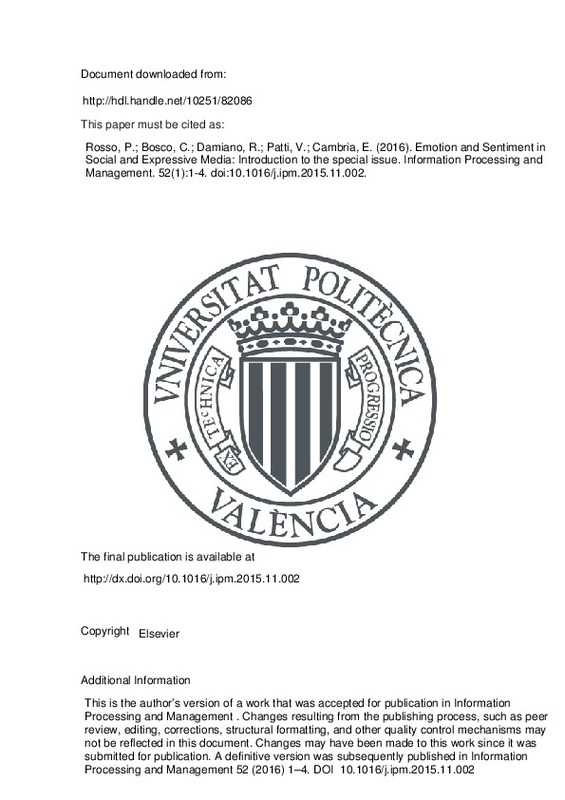Rosso, P.; Bosco, C.; Damiano, R.; Patti, V.; Cambria, E. (2016). Emotion and Sentiment in Social and Expressive Media: Introduction to the special issue. Information Processing and Management. 52(1):1-4. https://doi.org/10.1016/j.ipm.2015.11.002
Por favor, use este identificador para citar o enlazar este ítem: http://hdl.handle.net/10251/82086
|
Título:
|
Emotion and Sentiment in Social and Expressive Media: Introduction to the special issue
|
|
Autor:
|
 Rosso, Paolo
Bosco, Cristina
Damiano, Rossana
Patti, Viviana
Cambria, Erik
Rosso, Paolo
Bosco, Cristina
Damiano, Rossana
Patti, Viviana
Cambria, Erik
|
|
Entidad UPV:
|
Universitat Politècnica de València. Escola Tècnica Superior d'Enginyeria Informàtica
|
|
Fecha difusión:
|
|
|
Resumen:
|
[EN] Social and expressive media represent a challenge and a push forward for research on emotion and sentiment analysis. The
advent of social media has brought about new paradigms of interaction that foster first-person ...[+]
[EN] Social and expressive media represent a challenge and a push forward for research on emotion and sentiment analysis. The
advent of social media has brought about new paradigms of interaction that foster first-person engagement and crowdsourced
contents: the subjective dimension moves to the foreground, opening the way to the emergence of an affective component
within a dynamic corpus of digitized contents created and enriched by the users. Expressive media, which play a key role in
fields related to creativity, such as figurative arts, music or drama, gather multimedia contents into online social environments,
by joining the social dimension with the aims of artistic creation and self-expression. Artistic creation and performance seem
to be a very interesting testbed for cross-validating and possibly integrating approaches, models and tools for automatically
analyzing emotion and sentiment. In fact, in such contexts the social and affective dimensions (emotions and feelings) naturally
emerge (Silvia, 2005), think for instance of the visitors’ feedback to a real or virtual art exhibition, or of the audience–performance
interaction (...) In light of these considerations, this special issue focuses on the presentation and discussion of a set of novel computational
approaches to the analysis of emotion and sentiment in social and expressive media.
[-]
|
|
Palabras clave:
|
Sentiment analysis
,
Affective processing
,
Social media
,
Expressive media
|
|
Derechos de uso:
|
Reserva de todos los derechos
|
|
Fuente:
|
Information Processing and Management. (issn:
0306-4573
)
|
|
DOI:
|
10.1016/j.ipm.2015.11.002
|
|
Editorial:
|
Elsevier
|
|
Versión del editor:
|
http://dx.doi.org/10.1016/j.ipm.2015.11.002
|
|
Código del Proyecto:
|
info:eu-repo/grantAgreement/MINECO//TIN2012-38603-C02-01/ES/DIANA-APPLICATIONS: FINDING HIDDEN KNOWLEDGE IN TEXTS: APPLICATIONS/
info:eu-repo/grantAgreement/EC/FP7/269180/EU/Web Information Quality Evaluation Initiative/
|
|
Descripción:
|
This is the author’s version of a work that was accepted for publication in Information Processing and Management . Changes resulting from the publishing process, such as peer review, editing, corrections, structural formatting, and other quality control mechanisms may not be reflected in this document. Changes may have been made to this work since it was submitted for publication. A definitive version was subsequently published in Information Processing and Management 52 (2016) 1–4. DOI 10.1016/j.ipm.2015.11.002
|
|
Agradecimientos:
|
Paolo Rosso has been partially funded by the WIQ–EI IRSES project (Grant no. 269180) within the EC FP7 Marie Curie People Framework and by the DIANA-APPLICATIONS – Finding Hidden Knowledge in Texts: Applications project ...[+]
Paolo Rosso has been partially funded by the WIQ–EI IRSES project (Grant no. 269180) within the EC FP7 Marie Curie People Framework and by the DIANA-APPLICATIONS – Finding Hidden Knowledge in Texts: Applications project (TIN2012-38603-C02-01). The last phase of the work of Viviana Patti was carried out at the Universitat Politècnica de València in the framework of a three-month fellowship of the University of Turin within the World Wide Style (WWS) Program, Second Edition, co-funded by Fondazione CRT .
[-]
|
|
Tipo:
|
Artículo
|







![[Cerrado]](/themes/UPV/images/candado.png)


